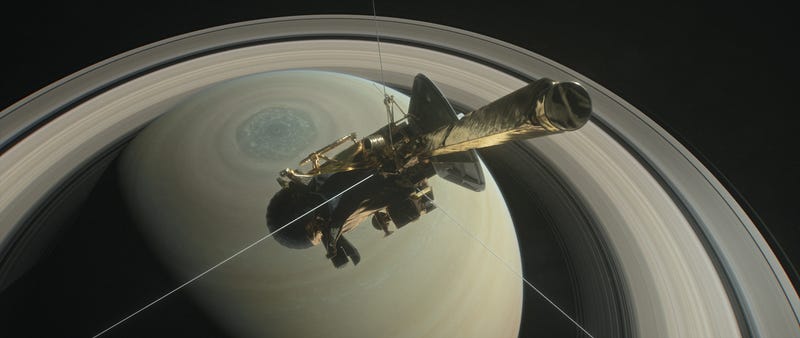
As things here on Earth become increasingly more Theater of the Absurd, NASA’s Cassini spacecraft whizzes millions of miles away, unaffected by our intra-human squabbling. After 20 years of heading toward and exploring the Saturn system, on September 15th, Cassini will plunge itself into the planet’s atmosphere, broadcasting the whole thing like a tearfully beautiful sequel to The Iron Giant.
The intrepid orbiter begins its final five Grand Finale passes around Saturn on August 14th, making the beginning of the end much more real. Still, there’s a lot to love about these last dives between the gas giant and its rings—according to NASA, Cassini will be catching whiffs of Saturn’s atmosphere, breezing between 1,010 and 1,060 miles (1,630 and 1,710 kilometers) above Saturn’s cloud tops at its closest. At these altitudes, the atmosphere is expected to be so dense that the probe will have to use its thrusters to maintain stability. Depending on how much Saturnian air Cassini encounters, NASA may choose to nudge the spacecraft a bit further down, or have it raise its orbit for safety.
As it has dutifully done in the past, Cassini will study Saturn’s auroras and the hexagonal vortex at Saturn’s North Pole—this time, with unprecedented closeness and detail.
“As it makes these five dips into Saturn, followed by its final plunge, Cassini will become the first Saturn atmospheric probe,” Linda Spilker, Cassini project scientist at NASA’s Jet Propulsion Laboratory (JPL), said in a press release. “It’s long been a goal in planetary exploration to send a dedicated probe into the atmosphere of Saturn, and we’re laying the groundwork for future exploration with this first foray.”
So although Cassini’s time is coming to a close, it has a lot more to do before it’s lights go out for good. For one thing, the orbiter could still help us solve the mystery of how long a Saturnian day really is. There’s no better spacecraft to tackle this and so many other lingering questions than the one who’s been zooming around Saturn for over a decade.
Still, we’ll miss our favorite hunk of metal once it’s gone.
[NASA]